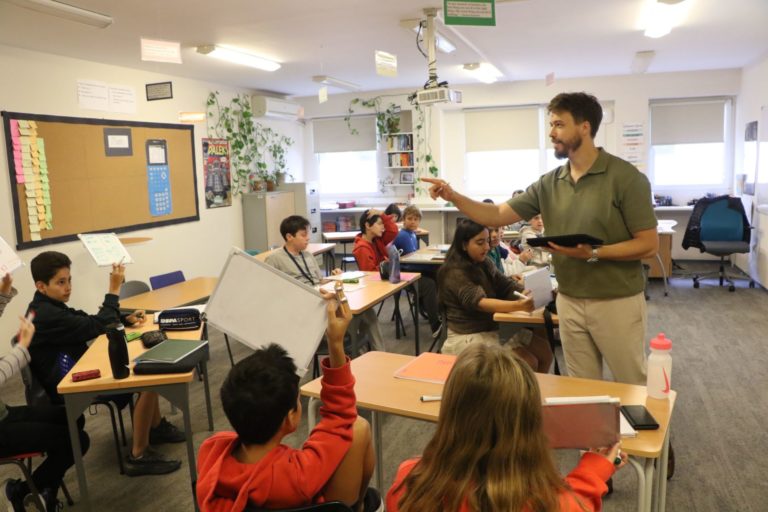My Classroom, My Rules

By Adrian Strooberg
Grade 6 Team Lead, Maths and English Teacher at The International School of Azerbaijan.
Published:
Learning the Hard Way
I will admit it. I used to think students should just behave. I do not know why. Maybe I thought good manners were instinctive, like breathing. Maybe I pictured my classroom as a scene from Matilda, where Miss Trunchbull reigns supreme and every student is on the brink of revolt. I was not exactly like her of course, but some mornings it felt that way.
Over the years, I have learned something critical. Students do not automatically know how to behave. As Tom Bennett reminds us, “Students need to be taught how to behave” (p.50). This was a turning point for me. Behaviour is not automatic, it is taught, modelled, and reinforced, just like any other skill in school.
And the truth is this: every conceivable aim of education is supported by good behaviour (p.29). If we want children to learn, thrive, and enjoy school, we have to prioritise the conditions that make that possible (no compromises).
Teaching Routines from Day One At the start of every school year, I take time (a lot of time) to set routines in my classes. We cover everything…everything. This is just a fraction, but for example, I teach them how we enter and exit the classroom. How we ask and answer questions. How we participate in discussions, even what discussions should look like. We talk about voice levels in the classroom, I show them and demonstrate to them what is appropriate, and what is not. I show them how to write on mini-whiteboards and their notebooks, we practice it, and we revise it.
I do not just expect students to follow rules. I teach them. I show them what I expect every single lesson. There is no debate, this is what I expect in my room. If you struggle, I support and guide you. It’s black and white, no grey areas.
Bennett explains it clearly: “Good behaviour in a classroom is an act of constant maintenance, it is an act of constant creation” (p.33). This resonates deeply with my practice. Behaviour management is never “done.” It is daily, deliberate, and ongoing.
It sounds simple. The impact, however, is huge. Once routines are embedded, the classroom hums. We get through content faster. Students actually learn faster, and they learn more. My students’ scores and data back it up. “Noisy classes mean that some or many of the children can’t focus or listen when they need to” (p.29). That one line captures why routines matter so much. Clarity and calmness are not optional, they are the foundation for learning.
Sharing Knowledge with Colleagues This year, I am stepping out of my comfort zone and doing something I have never done before. I am leading a book club for the secondary staff at the international school where I work, where we focus on behaviour management. We will share experiences, reflect on challenges, and learn from each other.
The book guiding us is Running the Room by Tom Bennett. It is a fantastic resource whether you are new to teaching or have decades of experience.
One idea that sparked our conversation is this: “The room must be run. If a teacher doesn’t run it, the students will, because power abhors a vacuum” (p.53). We have seen this play out in real classrooms. If we do not establish expectations, students fill that gap with their own. And usually, that “order” is not one that helps anyone learn.
Priorities in the Classroom
One quote from Tom Bennett really resonates. He says, “Our number one priority as teachers is to keep children safe. Our second priority is to teach them” (p.37). Let that sink in. Some teachers get this backwards. They focus solely on teaching content while leaving safety, respect, and structure on the back burner.
“Well managed, well behaved school spaces are essential for children to be safe…Students deserve to be safe. So do teachers” (p.31). This is not an add-on. It is the core of what we do. When students feel safe, when teachers feel respected, learning can take place.
Practical Advice for Teachers If you are reading this and feel helpless or like you are constantly fighting fires in your classroom, you are not alone. Or you might be like me and think that your behaviour management is great, until you get that one class that you hate to teach because the kids don’t listen.
I wish I had known these things a few years ago. Here are some tips to get started:
- Start small and be consistent. Pick a few routines to teach clearly at the start of the year. Reinforce them every lesson until they stick.
- It’s never too late to start teaching routines, you can do a class reset any time of the year (it’s just a bit more difficult). It’s like the old Chinese proverb, the best time to plant a tree was yesterday, the second best time is today.
- Model the behaviour you expect. Students notice everything. Show them how to ask questions politely, participate in discussions, and transition between activities smoothly.
“Students should be immersed in a classroom where good conduct is heard, seen, demonstrated, encouraged and expected all the time…good behaviour should be the atmosphere they breathe” (p.56). This image really helps me picture the kind of classroom culture I want to build.
- Do not be afraid to reteach. Even if you think students should know better, showing them the expected behaviour again is not a failure. It is teaching. P.S. Do this before it becomes a problem, and remind them about it when things are going well.
- Reflect on your own practice. Even if you consider yourself a good teacher, ask yourself: could I be even better at routines and behaviour management? Small tweaks can have a big impact.
- Finally, remember that “proactive strategies should be in place; reactive strategies are what most use (badly)” (p.57). Prevention always beats correction.
Read or listen to Running the Room. The audiobook voiced by Tom Bennett himself is hilarious, relatable, and full of practical strategies. You will laugh out loud and leave each chapter with actionable tips for your classroom. Take notes!
The Results
Yes, my classroom has rules. Yes, I spend time teaching them. Yes, it works. Students know what to expect from me. I know what to expect from them. We get on with learning with no fuss.
Teaching math is much more fun when the chaos of a Matilda-style classroom is left firmly on the movie screen. And in its place is something far more powerful: a safe, structured environment where learning flourishes, because behaviour was given the priority it deserves.
I hope that all CEESA teachers ejoyed a positive start to the 2025-26 school year in environments where all our students and staff thrive.
Reference
Bennett, T. (2020). Running the Room: The Teacher’s Guide to Behaviour. London: John Catt Educational.

